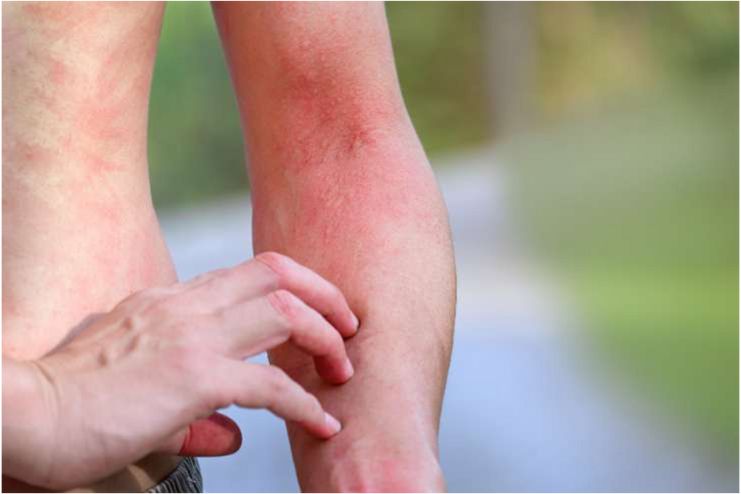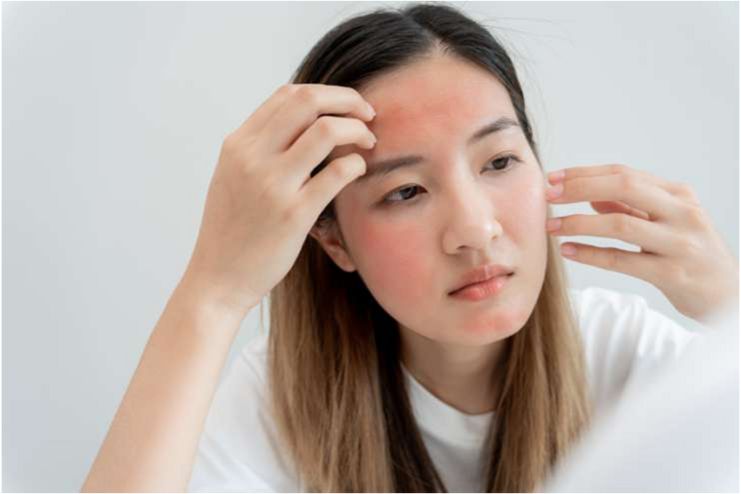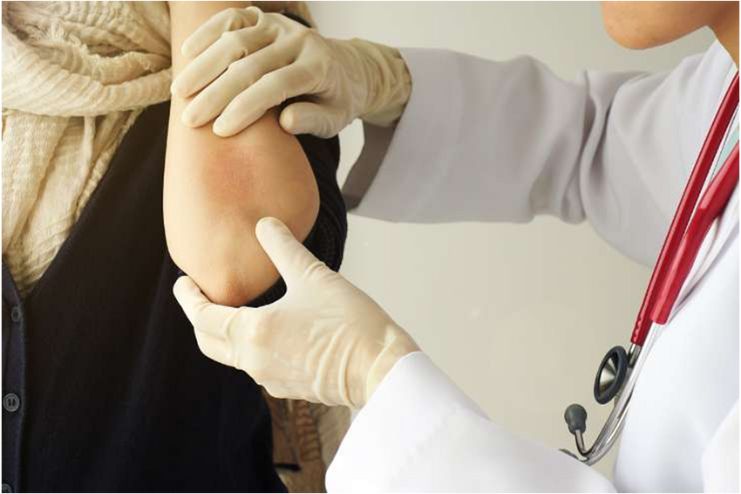Affiliate Disclaimer
Some links in this article are affiliate links. We may earn a small commission if you make a purchase through these links, at no extra cost to you. We only recommend products we find useful to our readersRashes on the skin may cause discomfort and may sometimes interfere with the quality of life. Lupus rash is no exception and may damage one’s beauty and confidence. Although it can take on various shapes throughout the body, this rash usually shows up as a butterfly-shaped redness on the nose and cheeks. More than merely a cosmetic issue, lupus rash frequently indicates an underlying disease flare-up.
These rashes can majorly influence everyday activities, emotional health, and self-esteem. Early rash detection and treatment are essential for treating Lupus and reducing flare-ups because the condition can be unpredictable. Learn about lupus rashes in this HealthSpectra post to be well-informed and lead a better life.
What Is Lupus and Types Of Lupus?
Lupus is an immune system disorder also known as systemic lupus erythematosus. When immune cells attack the healthy tissues of the body, tissue damage and inflammation occur. Usually, the symptoms are restricted to the skin, but they may also cause internal problems like joint pain. Severe cases also damage the kidneys, heart, and other vital organs.
Lupus is usually referred to as systemic lupus erythematosus (SLE), the most common and severe type. Other types include Cutaneous lupus erythematosus (or discoid Lupus), which doesn’t cause organ damage. Drug-induced systemic Lupus is also observed in people ingesting certain medications. Drug-induced Lupus can occur when some medicines (such as hydralazine and procainamide) are used.
The exact cause of Lupus is not known. However, genetic makeup, viruses, and environmental chemicals contribute to the disease.
According to the Lupus Foundation of America, at least five million people globally and 1.5 million Americans have some Lupus. Women of reproductive age are most commonly affected by Lupus. However, Lupus can also strike males, kids, and teenagers. Women make up ninety percent (90%) of lupus patients. Most lupus patients get the condition between the ages of 15 and 44.
The risk is higher if you are:
- African-American
- Hispanics
- Asians
- Native Americans
Symptoms Of Lupus:

The major symptoms of Lupus are skin rashes, which are usually called lupus skin rashes. However, other symptoms also accompany it.
- Joint Pain: Joint pain is a lupus sign. It occurs on both sides of the body and affects the fingers, hands, wrists, and knees. The joints look inflamed and warm to the touch.
- Butterfly Rash (malar rash): This is another Lupus symptom that forms a butterfly-shaped rash across the cheeks and bridges other noses. Other symptoms include sensitivity to the sun, a scaly purple rash, or red spots across body parts like the neck, face, and arms.
- Swelling in Legs or Around Eyes: Swelling, especially in the legs and around the eyes, can result from fluid retention brought on by Lupus. It happens due to kidney and blood vessel inflammation, which throws off the body’s natural fluid balance. Sustained swelling could indicate a lupus flare, which calls for immediate medical intervention to control the illness.
- Fatigue and fever: Fatigue and fever may be associated with Lupus. At times, fatigue may also interfere with daily activities and exercise. Some people experience a low-grade unexplained fever occasionally.
- Sensitivity to light: People with Lupus are highly sensitive to ultraviolet light and the sun. Exposure to sunlight may trigger a skin rash and worsen existing symptoms.
- Hair loss: Lupus symptoms tend to come and go. At times, patients may observe hair falling in patches or thinner hair across the scalp. New hair may begin to grow back when the flare-up is over.
- Dizziness and Headache: Patients with lupus frequently experience headaches and dizziness, commonly caused by inflammation that affects the blood vessels or brain. These symptoms, which can include disorientation or alterations in vision, can range from minor to fatal.
Check below for more pictures of lupus skin rash, especially of Lupus on feet and Lupus on legs.
How To Diagnose Lupus?

It may be tricky to diagnose Lupus as the symptoms indicate other medical conditions. For example, swelling and joint pain resemble the symptoms of rheumatoid arthritis. On the other hand, rashes, joint discomfort, and exhaustion may distinguish Lupus.
A blood test for antinuclear antibodies (ANAs) can be a clue for Lupus. Other lab tests test for kidney functioning, cell counts, and clotting time. A tissue biopsy may help with diagnosis.
Natural Remedies for Lupus Rash
As of right now, Lupus has no known cure. Treatment goals are to minimize organ damage, alleviate symptoms, and stop flare-ups. Although there are natural remedies for Lupus, their efficacy is unknown. According to the Office on Women’s Health, although research has not yielded precise data about natural remedies’ advantages and potential risks, some individuals who attempt them claim to benefit from them.
Many people use natural therapies to find calming respite from the discomfort of lupus rashes. These are some of the most widely used options; each has special therapeutic qualities.
Curcumin
Turmeric contains a chemical called curcumin. Researchers have found that curcumin has anti-inflammatory, antibacterial, and antioxidant qualities in patients with systemic lupus erythematosus (SLE). Additionally, curcumin may have immunomodulatory properties, which could help lower the immunological response.
A 2022 review states that prior research indicates curcumin may aid in treating SLE by blocking the formation of antibodies and avoiding oxidative stress and B cell activation. However, further extensive testing is required to ascertain its effects and safety.
Fish oils with omega-3
Certain foods, especially fish, naturally contain chemicals called omega-3 fatty acids. These acids may be helpful for Lupus because they have anti-inflammatory properties.
A 2022 systematic review investigated the effects of fish oil on SLE and cutaneous lupus erythematosus (CLE), a kind of SLE that affects the skin. In one study, omega-3 fish oils positively impacted the Systemic Lupus Activity Measure (SLAM) score, which the researchers used to measure the severity of the condition, improving skin findings.
Vitamin D
SLE patients are expected to have a vitamin D deficit. According to one review, Vitamin D insufficiency may worsen SLE or be a risk factor for illness, while SLE may also cause vitamin D levels to drop.
This is significant because vitamin D regulates the immune system. Sunlight, however, is a primary source of vitamin D and can aggravate lupus symptoms. Taking vitamin D supplements may benefit those suffering from the illness.
Medical Treatments for Lupus

Medications for Lupus include corticosteroid creams for rashes, nonsteroidal anti-inflammatory drugs (NSAIDs) for fever and joint pain, and antimalarial medications for rashes, ulcers, and joint pain. In severe cases, corticosteroids may be prescribed as pills or intravenous injections.
Self-Care for Lupus:
Lifestyle changes may help reduce lupus flare-ups in the long term.
- Cover up when exposed to the sun
- Quit smoking
- Exercise regularly
- Improve stress management skills
- Rest enough
Note: People with lupus require 8-10 hours of sleep at night
Complications Associated With Lupus:
- As Lupus progresses, it may interfere with various organs of the body. Three in four lupus patients develop kidney problems. The problems are not evident but may show up as swelling in ankles and legs.
- In many cases, lupus is also associated with heart problems, such as the formation of the sac around the heart, causing severe pain in the chest. Lupus patients will likely develop plaques that clog arteries, resulting in coronary artery disease.
- In many lupus patients, the lungs become inflamed, leading to chest pain, painful breathing, etc.
- Some may experience digestive system problems like belly pain, vomiting, nausea, liver inflammation, swallowing difficulty, or pancreas.
- Some lupus patients may also tend to reduce weight during flare-ups.
- Anemia may be observed in some lupus patients as the body quickly destroys red blood cells rather than replaces them.
- Different nervous system problems like headaches are triggered.
- The disease may also be related to memory problems, anxiety, depression, and seizures.
- In most cases, babies born to women with Lupus are healthy. In some instances, the newborn may show neonatal Lupus.
Conclusion
Most people with Lupus can lead an everyday or nearly everyday life, continuing daily activities with minimal disruption. However, when lupus symptoms, such as the lupus rash, flare up, it’s crucial to seek prompt treatment. Effective management options range from natural therapies to conventional treatments like steroid creams. Thanks to advances in treatment, people with lupus can live longer. It’s important to monitor symptoms, explore appropriate remedies, and consult a healthcare provider to develop a personalized treatment strategy. Timely medical guidance helps control flare-ups and better manage Lupus and its symptoms.
-
Jan 2018Written by Sumana Maheswari
-
Nov 2024Edited by Ankita
References
- https://my.clevelandclinic.org/health/symptoms/23163-lupus-rash
- https://www.aad.org/public/diseases/a-z/lupus-treatment
- https://www.hopkinsmedicine.org/health/conditions-and-diseases/lupus/types-of-lupus
- https://www.cdc.gov/lupus/glossary/index.html
- https://www.medicalnewstoday.com/articles/types-of-lupus
- https://www.lupus.org/resources/lupus-facts-and-statistics
- https://www.mayoclinic.org/diseases-conditions/lupus/symptoms-causes/syc-20365789
- https://medlineplus.gov/lupus.html
- https://www.womenshealth.gov/lupus/lupus-diagnosis-and-treatment
- https://pmc.ncbi.nlm.nih.gov/articles/PMC5743852/
- https://www.medicalnewstoday.com/articles/natural-treatment-for-lupus
- https://nyulangone.org/conditions/systemic-lupus-erythematosus/support
In this Article



















